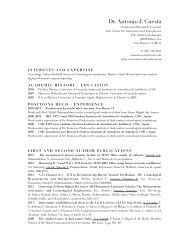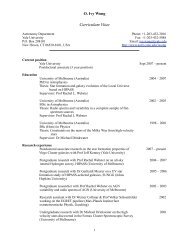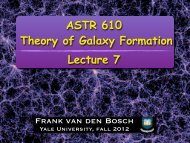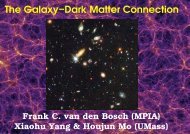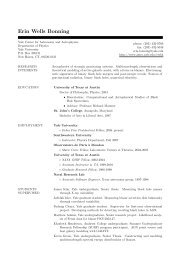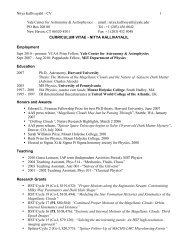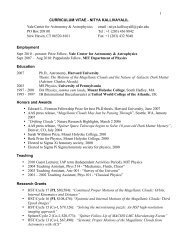ASTR 610 Theory of Galaxy Formation Lecture 16
ASTR 610 Theory of Galaxy Formation Lecture 16
ASTR 610 Theory of Galaxy Formation Lecture 16
You also want an ePaper? Increase the reach of your titles
YUMPU automatically turns print PDFs into web optimized ePapers that Google loves.
<strong>ASTR</strong> <strong>610</strong><br />
<strong>Theory</strong> <strong>of</strong> <strong>Galaxy</strong> <strong>Formation</strong><br />
<strong>Lecture</strong> <strong>16</strong><br />
Frank van den Bosch<br />
Yale University, fall 2012
The Structure & <strong>Formation</strong> <strong>of</strong> Disk Galaxies<br />
In this lecture we discuss the structure and formation <strong>of</strong> disk galaxies.<br />
After a very brief overview <strong>of</strong> some <strong>of</strong> the main observational properties <strong>of</strong> disk<br />
galaxies, we discuss the `standard model’ for disk galaxy formation. We discuss<br />
some successes and failures <strong>of</strong> this model, and the implications.<br />
Topics that will be covered include:<br />
Exponential Disks<br />
Tully-Fisher Relation<br />
Angular Momentum Catastrophe<br />
Viscosity & Resonant Scattering<br />
Adiabatic Contraction<br />
Angular Momentum Distributions<br />
<strong>ASTR</strong> <strong>610</strong>: <strong>Theory</strong> <strong>of</strong> <strong>Galaxy</strong> <strong>Formation</strong> © Frank van den Bosch: Yale 2012
Structure & <strong>Formation</strong><br />
<strong>of</strong> Disk Galaxies
Disk Galaxies: Observational Facts<br />
Flat Rotation Curves<br />
Disk galaxies have flat rotation curves. Unfortunately, it is difficult to obtain<br />
unique disk-halo(-bulge) decompositions....<br />
NFW halo<br />
disk (stars)<br />
disk (gas)<br />
A frequently used decomposition is the one that maximizes the contribution due<br />
to the stellar disk (i.e., with a maximum M/L ratio for the stars). This is called<br />
a `maximal disk’ decomposition....<br />
<strong>ASTR</strong> <strong>610</strong>: <strong>Theory</strong> <strong>of</strong> <strong>Galaxy</strong> <strong>Formation</strong> © Frank van den Bosch: Yale 2012
Disk Galaxies: Observational Facts<br />
Exponential Surface Brightness Pr<strong>of</strong>iles<br />
Disk galaxies have surface brightness pr<strong>of</strong>iles that <strong>of</strong>ten are close to exponential.<br />
Deviations from exponential at small radii are attributed to bulge and/or bar.<br />
Deviations from exponential at large radii are attributed to star formation<br />
thresholds, radial migration, and/or maximum angular momentum...<br />
disk<br />
disk<br />
disk<br />
bulge<br />
bulge<br />
bulge<br />
Assuming that the disk is intrinsically round, and infinitesimally flat, the inclination<br />
angle follows from cos i = b/a, with a and b the semi-major and semi-minor axes.<br />
Hence, face-on and edge-on correspond to i=0 o and i=90 o , respectively.<br />
<strong>ASTR</strong> <strong>610</strong>: <strong>Theory</strong> <strong>of</strong> <strong>Galaxy</strong> <strong>Formation</strong> © Frank van den Bosch: Yale 2012
Disk Galaxies: Observational Facts<br />
Exponential Surface Brightness Pr<strong>of</strong>iles<br />
Because <strong>of</strong> their close-to-exponential appearance, disk galaxies are <strong>of</strong>ten modelled<br />
as infinitesimally thin, exponential disks:<br />
surface brightness<br />
surface mass density<br />
I(R) =I 0 e −R/R d<br />
Σ(R) =Σ 0 e −R/R d<br />
L d =2π<br />
M d =2π<br />
∞<br />
0<br />
∞<br />
0<br />
I(R) R dR =2π I 0 R 2 d<br />
Σ(R) R dR =2π Σ 0 R 2 d<br />
circular velocity<br />
V 2<br />
c,d(R) =−4πGΣ 0 R 2 d y [I 0 (y) K 0 (y) − I 1 (y) K 1 (y)]<br />
disk scale length<br />
R d stellar mass-to-light ratio M d /L d =Σ 0 /I 0<br />
y ≡ R/(2 R d )<br />
modified Bessel functions<br />
I n (x) K n (x)<br />
The circular velocity curve reaches a maximum at R 2.<strong>16</strong> R d<br />
For more realistic models, with non-zero thickness, see MBW §11.1.1...<br />
<strong>ASTR</strong> <strong>610</strong>: <strong>Theory</strong> <strong>of</strong> <strong>Galaxy</strong> <strong>Formation</strong> © Frank van den Bosch: Yale 2012
gas mass fraction<br />
Disk Galaxies: Observational Facts<br />
Scaling Relations<br />
Brighter disks<br />
are larger<br />
are redder<br />
have higher central SB<br />
have smaller gas mass fractions<br />
rotate faster (Tully-Fisher relation)<br />
McGaugh & de Blok, 1997, ApJ, 534, 146<br />
MBW, Fig. 2.20<br />
red<br />
blue<br />
vdBosch & Dalcanton, 2000, ApJ, 534, 146<br />
<strong>ASTR</strong> <strong>610</strong>: <strong>Theory</strong> <strong>of</strong> <strong>Galaxy</strong> <strong>Formation</strong> © Frank van den Bosch: Yale 2012
Disk Galaxies: Observational Facts<br />
Scaling Relations<br />
Tully-Fisher (TF) relation:<br />
V ∝ L 0.30<br />
I<br />
The slope <strong>of</strong> the TF relation<br />
depends on photometric band.<br />
It typically gets larger for<br />
bluer bands.<br />
Source: Courteau et al. 2007, ApJ, 671. 203<br />
Getting models and simulations<br />
to reproduce the zero-point <strong>of</strong><br />
the TF relation is a challenging<br />
problem that is still not<br />
entirely solved...<br />
The scatter in TF relation is<br />
NOT correlated with surface<br />
brightness. As we will see, this<br />
gives important insight into the<br />
origin <strong>of</strong> the TF relation.<br />
<strong>ASTR</strong> <strong>610</strong>: <strong>Theory</strong> <strong>of</strong> <strong>Galaxy</strong> <strong>Formation</strong> © Frank van den Bosch: Yale 2012
The <strong>Formation</strong> <strong>of</strong> Disk Galaxies<br />
Hot (shock-heated) gas inside extended<br />
dark matter halo cools radiatively,<br />
As gas cools, its pressure decreases<br />
causing the gas to contract<br />
Since emission <strong>of</strong> photons is<br />
isotropic, angular momentum<br />
<strong>of</strong> cooling gas is conserved.<br />
As gas sphere contracts,<br />
it spins up, and flattens<br />
Surface density <strong>of</strong> disk increases, `triggering’<br />
star formation; a disk galaxy is born...<br />
<strong>ASTR</strong> <strong>610</strong>: <strong>Theory</strong> <strong>of</strong> <strong>Galaxy</strong> <strong>Formation</strong> © Frank van den Bosch: Yale 2012
The <strong>Formation</strong> <strong>of</strong> Disk Galaxies<br />
The Standard Picture<br />
Disk galaxies are in centrifugal equilibrium; their<br />
structure is therefore governed by their (specific)<br />
angular momentum distribution.<br />
Michael Fall<br />
George Efstathiou<br />
The standard picture <strong>of</strong> disk formation, which was introduced in a seminal paper by<br />
Fall & Efstathiou (1980), is based on the following three “assumptions”:<br />
the angular momentum originates from cosmological torques<br />
baryons & dark matter acquire identical specific angular momentum distributions<br />
baryons conserve their specific angular momentum while cooling<br />
Houjun Mo Shude Mao Simon White<br />
This standard picture was `modernized’ in another<br />
seminal paper, by Mo, Mao & White (1998), and has<br />
subsequently been extended/revised by numerous<br />
studies (e.g., van den Bosch 1998, 2000, 2002;<br />
Dutton et al .2007; Dutton & van den Bosch 2012).<br />
<strong>ASTR</strong> <strong>610</strong>: <strong>Theory</strong> <strong>of</strong> <strong>Galaxy</strong> <strong>Formation</strong> © Frank van den Bosch: Yale 2012
Angular Momentum Transport<br />
J<br />
For a given angular momentum, , the state <strong>of</strong> lowest energy, and hence the state<br />
preferred by nature, is the one in which all mass except an infinitesimal fraction<br />
collapses into a black hole, while is on a Keplerian orbit with radius given by<br />
δM<br />
J = δM (GMR) 1/2<br />
R<br />
δM<br />
where<br />
M<br />
is the mass <strong>of</strong> the black hole.<br />
Clearly, this is very different from a realistic disk galaxy, whose mass distribution is<br />
close to exponential.....<br />
Reason for this paradox is that although lowest energy state is preferred, its<br />
realization requires very efficient transport <strong>of</strong> angular momentum from inside out.<br />
There are several mechanisms that can cause such angular momentum transport:<br />
secular<br />
evolution<br />
viscosity (gas only)<br />
resonant scattering (stars & gas)<br />
(Lin & Pringle 1987)<br />
(Sellwood & Binney 2002)<br />
hierarchical<br />
formation<br />
dynamical friction & ram pressure acting on gas clouds<br />
“angular momentum catastrophe”<br />
<strong>ASTR</strong> <strong>610</strong>: <strong>Theory</strong> <strong>of</strong> <strong>Galaxy</strong> <strong>Formation</strong> © Frank van den Bosch: Yale 2012
Angular Momentum Catastrophe<br />
The fact that disk galaxies have a structure that deviates strongly from their<br />
minimal energy state indicates that these processes are not very efficient.<br />
In simulations, however, efficient cooling<br />
causes much gas to condense into clumps at<br />
centers <strong>of</strong> subhaloes. This gas is delivered<br />
to disk via dynamical friction, transferring<br />
(orbital) angular momentum <strong>of</strong> gas to dark<br />
matter disks end-up much too small.<br />
This problem is known as the<br />
angular momentum catastrophe<br />
and requires feedback to prevent most <strong>of</strong><br />
the gas from cooling in small haloes.<br />
Source: Steinmetz & Navarro, 1999, ApJ, 513, 555<br />
Although the secular processes are not very efficient, they cannot be neglected.<br />
Radial migration <strong>of</strong> stars due to resonant scattering <strong>of</strong> spirals (and bars) can cause<br />
significant redistribution <strong>of</strong> angular momentum within disk (e.g., Roškar et al. 2008)<br />
<strong>ASTR</strong> <strong>610</strong>: <strong>Theory</strong> <strong>of</strong> <strong>Galaxy</strong> <strong>Formation</strong> © Frank van den Bosch: Yale 2012
Disk <strong>Formation</strong>: The Standard Picture<br />
As a starting point, consider the following idealized case:<br />
self-gravity <strong>of</strong> the disk can be ignored<br />
dark matter halo is a singular, isothermal sphere ρ(r) =V 2<br />
vir/(4πGr 2 )<br />
Using the virial scaling relations between virial mass, virial radius and virial velocity<br />
<strong>of</strong> dark matter haloes (see lecture 9), and assuming that the mass that settles in<br />
the disk is a fraction m d <strong>of</strong> that <strong>of</strong> the total virial mass, we have that<br />
where<br />
<br />
M d = m d M vir 1.3 × 10 11 h −1 md<br />
3<br />
V vir<br />
M ⊙ D −1 (z)<br />
0.05 200 km/s<br />
D(z) =<br />
1/2 <br />
∆vir (z) H(z)<br />
100<br />
H 0<br />
accounts for the redshift dependence.<br />
Under the assumption that the disk is an infinitesimally thin, exponential,<br />
J d =2π<br />
∞<br />
0<br />
Σ(R) V c (R) R 2 dR =2M d R d V vir<br />
<strong>ASTR</strong> <strong>610</strong>: <strong>Theory</strong> <strong>of</strong> <strong>Galaxy</strong> <strong>Formation</strong> © Frank van den Bosch: Yale 2012
Disk <strong>Formation</strong>: The Standard Picture<br />
j d<br />
J d ≡ j d J vir<br />
If we define the parameter via , where is the angular<br />
momentum <strong>of</strong> the dark matter halo, then we can related J d to the spin parameter<br />
<strong>of</strong> the dark matter halo, according to<br />
J vir<br />
λ = J vir |E| 1/2<br />
GM 5/2<br />
vir<br />
= 1 j d<br />
J d |E| 1/2<br />
GM 5/2<br />
vir<br />
Using the virial theorem, according to which<br />
E = −K = − M vir V 2<br />
vir<br />
2<br />
, we have that<br />
J d = √ 2 j d λM vir R vir V vir<br />
J d =2M d R d V vir<br />
R d = √ 1 λ 2<br />
M d = m d M vir<br />
<br />
jd<br />
m d<br />
<br />
R vir<br />
Using the virial scaling relations for dark matter haloes this yields<br />
R d 10h −1 kpc<br />
<br />
jd λ<br />
m d 0.05<br />
Vvir<br />
200 km/s<br />
<br />
D −1 (z)<br />
<strong>ASTR</strong> <strong>610</strong>: <strong>Theory</strong> <strong>of</strong> <strong>Galaxy</strong> <strong>Formation</strong> © Frank van den Bosch: Yale 2012
Disk <strong>Formation</strong>: The Standard Picture<br />
R d 10h −1 kpc<br />
<br />
jd λ<br />
m d 0.05<br />
Vvir<br />
200 km/s<br />
<br />
D −1 (z)<br />
Consider the MW: Assume that<br />
V vir = V rot 220 km/s<br />
M d 5 × 10 10 M ⊙ R d 3.5kpc<br />
and that<br />
j d = m d<br />
Then, using that and the above relation implies<br />
m d ∼ 0.01<br />
λ ∼ 0.011<br />
f bar 0.17<br />
P (λ
Disk <strong>Formation</strong>: The Standard Picture<br />
As shown by Mo, Mao & White (1998; hereafter MMW), in this case one has that<br />
R d = 1 √<br />
2<br />
λ<br />
<br />
jd<br />
m d<br />
<br />
R vir F −1<br />
R F −1/2<br />
E<br />
new addition<br />
F E is defined by<br />
F R is defined by<br />
E = − M vir Vvir<br />
2<br />
2<br />
F R = 1 2<br />
Rvir /R d<br />
0<br />
F E<br />
u 2 e −u V c(uR d )<br />
V vir<br />
du<br />
see MMW for simple<br />
fitting functions for<br />
both F E and F R ....<br />
V 2<br />
c (R) =V 2<br />
c,d(R)+V 2<br />
c,h(R) =V 2<br />
c,d(R)+ GM h,ac(R)<br />
R<br />
contribution to<br />
rotation curve due to<br />
self-gravity <strong>of</strong> disk<br />
With this modification, the MW can be reproduced with<br />
λ m d 0.05 in much better agreement with expectations<br />
circular velocity <strong>of</strong> the dark<br />
matter halo, corrected for<br />
adiabatic contraction due to<br />
disk formation<br />
<strong>ASTR</strong> <strong>610</strong>: <strong>Theory</strong> <strong>of</strong> <strong>Galaxy</strong> <strong>Formation</strong> © Frank van den Bosch: Yale 2012
Adiabatic Contraction<br />
When baryons cool and concentrate in the center <strong>of</strong> a dark matter halo, the halo<br />
structure will be modified due to the gravitational action <strong>of</strong> the baryons.<br />
In general, it is difficult to model this action <strong>of</strong> disk on halo accurately, because it<br />
will depend on the detailed formation history <strong>of</strong> the disk-halo system.<br />
However, if growth <strong>of</strong> disk is slow compared to dynamical time <strong>of</strong> dark matter<br />
particles in (center) <strong>of</strong> halo, the system adjusts itself adiabatically (reversable):<br />
in this case the final state is independent <strong>of</strong> the path taken.<br />
If (i) the system is spherically symmetric, and (ii) all particles are on circular<br />
orbits, adiabatic invariance implies that the quantity r M(r) is conserved<br />
r f M f (r f )=r i M i (r i )<br />
Here M i (r) and M f (r) are the initial and final mass pr<strong>of</strong>iles<br />
In order to model adiabatic contraction, the above equation is <strong>of</strong>ten used, assuming<br />
that initially baryons and dark matter follow the same NFW pr<strong>of</strong>ile, while after<br />
disk formation<br />
M f (r f )=M d (r f ) + [1 − m d ] M i (r i )<br />
<strong>ASTR</strong> <strong>610</strong>: <strong>Theory</strong> <strong>of</strong> <strong>Galaxy</strong> <strong>Formation</strong> © Frank van den Bosch: Yale 2012
Adiabatic Contraction<br />
For given m d and M d (r) the above equations can be solved (iteratively) for r f given r i .<br />
For realistic values <strong>of</strong> md, the effect <strong>of</strong> AC can be very substantial, resulting in<br />
V rot /V vir >> 1, where V rot is the flat part <strong>of</strong> the rotation curve.<br />
In fact, since smaller spin parameters result in more compact disks, the actual ratio<br />
V rot /V vir is a strong function <strong>of</strong> λ: i.e., V rot is a poor indicator <strong>of</strong> V vir !!!<br />
van den Bosch, 2002, MNRAS, 332, 456<br />
λ =0.028 λ =0.060 λ =0.129<br />
Evolution <strong>of</strong> RCs in disk formation models.<br />
All three disks reside in haloes <strong>of</strong> the<br />
same mass, but with different spin<br />
parameters. Self-gravity <strong>of</strong> disk and AC<br />
are both taken into account<br />
Many studies in the literature assume that V rot = V vir or V rot = V max , where the<br />
latter is the maximum circular velocity <strong>of</strong> the NFW halo (typically V max /V vir ~ 1.2)<br />
However, with self-gravity <strong>of</strong> disk and AC, one typically expects V rot /V vir ~ 1.4-1.8)<br />
<strong>ASTR</strong> <strong>610</strong>: <strong>Theory</strong> <strong>of</strong> <strong>Galaxy</strong> <strong>Formation</strong> © Frank van den Bosch: Yale 2012
Dutton, vdBosch, Dekel & Courteau, 2007, ApJ, 654, 27<br />
Adiabatic Contraction<br />
Note: r M(r) is only an adiabatic invariant for spherical systems with circular orbits.<br />
In reality disk growth results in halo contraction that is slightly different. This can<br />
be parameterized by stating that r f =Γ ν r i , where Γ=r f /r i in the simplified AC<br />
case discussed above, and ν is a `free parameter’.<br />
standard AC<br />
Simulations suggest that ν 0.8<br />
ν =1<br />
ν =0<br />
ν V max , which is simply due<br />
to the self-gravity <strong>of</strong> the disk<br />
Model predictions for the ratio V 2.2 /V vir for<br />
disk galaxies embedded in NFW haloes. Results<br />
are shown as function <strong>of</strong> the halo concentration<br />
parameter, c. Here V 2.2 is the rotation velocity<br />
<strong>of</strong> the disk measured at 2.2 disk scale-lengths.<br />
Results are shown for different `forms’ <strong>of</strong><br />
adiabatic contraction (different values <strong>of</strong> ν ).<br />
For comparison, the green curve shows the<br />
ratio V max /V vir .<br />
<strong>ASTR</strong> <strong>610</strong>: <strong>Theory</strong> <strong>of</strong> <strong>Galaxy</strong> <strong>Formation</strong> © Frank van den Bosch: Yale 2012
Lessons Learned<br />
Dutton et al. (2007) used an extended version <strong>of</strong> the MMW models to investigate<br />
what it takes for the models to reproduce the observational V-L-R scaling relations:<br />
Model Ingredients<br />
Exponential disks in contracted NFW haloes.<br />
AC modeled, treating ν as a free parameter.<br />
α<br />
M<br />
Disk mass fraction modelled as m d = m vir<br />
d,0 10 12 h −1 M ⊙<br />
with α and m d,0 two additional free parameter<br />
Bulge formation included as described in MBW §11.2.4<br />
Disk split in stars and (cold) gas using SF threshold density;<br />
material with Σ(R) > Σ crit (R) is turned into stars. This<br />
adds one more free parameter, the Toomre Q-parameter.<br />
The spin parameters <strong>of</strong> dark matter haloes follow a lognormal<br />
distribution with ¯λ DM =0.04 and σ ln λ =0.5<br />
We assume that<br />
λ gal = λ DM<br />
, i.e., that<br />
j d /m d =1<br />
<strong>ASTR</strong> <strong>610</strong>: <strong>Theory</strong> <strong>of</strong> <strong>Galaxy</strong> <strong>Formation</strong> © Frank van den Bosch: Yale 2012
Stellar Mass-to-Light Ratios<br />
MMW models can fit V-L-R scaling relations, but they assumed unrealistically low<br />
values for stellar mass-to-light ratios, and assumed that disk was entirely stellar<br />
(no cold gas). Stellar population models show that stellar mass-to-light ratios <strong>of</strong><br />
disk galaxies increase with luminosity, which will impact slopes <strong>of</strong> V-L-R relations....<br />
Source: Dutton, vdBosch, Dekel & Courteau, 2007, ApJ, 654, 27<br />
Dutton et al. (2007) took this into<br />
account by modelling the stellar<br />
mass-to-light ratios using the red<br />
line shown in the figure...<br />
<strong>ASTR</strong> <strong>610</strong>: <strong>Theory</strong> <strong>of</strong> <strong>Galaxy</strong> <strong>Formation</strong> © Frank van den Bosch: Yale 2012
Models Without Scatter<br />
Source: Dutton, vdBosch, Dekel & Courteau, 2007, ApJ, 654, 27<br />
The `original’ MMW model matches the slope and zeropoint <strong>of</strong> the TF<br />
relation, and even predicts roughly the correct size-luminosity relation.<br />
However, it adopts unrealistic stellar mass-to-light ratios, and assumes<br />
that all the disk matter is in the form <strong>of</strong> stars (no cold gas).<br />
<strong>ASTR</strong> <strong>610</strong>: <strong>Theory</strong> <strong>of</strong> <strong>Galaxy</strong> <strong>Formation</strong> © Frank van den Bosch: Yale 2012
Models Without Scatter<br />
Source: Dutton, vdBosch, Dekel & Courteau, 2007, ApJ, 654, 27<br />
Including the empirical relation between stellar mass-to-light ratio and<br />
disk luminosity results in VL and RL relations that are too steep....<br />
<strong>ASTR</strong> <strong>610</strong>: <strong>Theory</strong> <strong>of</strong> <strong>Galaxy</strong> <strong>Formation</strong> © Frank van den Bosch: Yale 2012
Models Without Scatter<br />
Source: Dutton, vdBosch, Dekel & Courteau, 2007, ApJ, 654, 27<br />
Σ(R) > Σ crit (R)<br />
Allowing only the disk matter with<br />
to form stars (the rest<br />
remains as cold gas), results in a TF relation with the correct slope, but with a<br />
zero-point that is ~2σ too high.<br />
The RL relation still has a slope that is too steep...<br />
<strong>ASTR</strong> <strong>610</strong>: <strong>Theory</strong> <strong>of</strong> <strong>Galaxy</strong> <strong>Formation</strong> © Frank van den Bosch: Yale 2012
Models Without Scatter<br />
Source: Dutton, vdBosch, Dekel & Courteau, 2007, ApJ, 654, 27<br />
One can adjust the disk-mass to halo-mass relation (i.e., α) in order to match<br />
the slope <strong>of</strong> the RL relation, but the zero-point <strong>of</strong> theTF relation is still ~2σ<br />
too high. Also, the disks are ~1σ too large...<br />
<strong>ASTR</strong> <strong>610</strong>: <strong>Theory</strong> <strong>of</strong> <strong>Galaxy</strong> <strong>Formation</strong> © Frank van den Bosch: Yale 2012
Solutions for the TF zero-point problem<br />
lower stellar mass-to-light ratios<br />
required:<br />
log(M/L) ∗ → log(M/L) ∗ +∆ IMF<br />
with<br />
∆ IMF −0.5<br />
problem: the most one can afford with changes in IMF is ∆ IMF ∼−0.2<br />
lower halo concentrations<br />
required:<br />
c(M) → ηc(M) η 0.4<br />
with<br />
problem: halo concentrations depend on cosmology; the model <strong>of</strong> Dutton et al.<br />
assumed WMAP1 cosmology. For WMAP3 cosmology η 0.75.<br />
Having η 0.4 implies a cosmology that is violently inconsistent with<br />
current cosmological constraints.<br />
modify adiabatic contraction<br />
required: halo expansion, i.e.,<br />
ν
Three Succesful Models with Scatter<br />
Source: Dutton, vdBosch, Dekel & Courteau, 2007, ApJ, 654, 27<br />
Model ν η Δ IMF<br />
I 0.8 0.8 -0.4<br />
II 1.0 0.5 -0.2<br />
III 0.0 0.8 -0.2<br />
AC parameter<br />
c(M) parameter<br />
All three models match slopes, zero-points and scatter <strong>of</strong> the observed TF and RL<br />
relations. However, the scatter in the observed RL relation requires σ ln λ ≤ 0.25<br />
σ ln λ 0.5<br />
For comparison, simulations predict that<br />
; Hence, disk galaxies may only<br />
form in a subset <strong>of</strong> all haloes, preferably those with smaller spin parameter (which<br />
are the ones that experienced a more quiescent formation history)...<br />
<strong>ASTR</strong> <strong>610</strong>: <strong>Theory</strong> <strong>of</strong> <strong>Galaxy</strong> <strong>Formation</strong> © Frank van den Bosch: Yale 2012
The Origin <strong>of</strong> Exponential Disks<br />
If there is no angular momentum loss (or redistribution) during the disk formation<br />
process, then the disk surface density pr<strong>of</strong>ile is a direct reflection <strong>of</strong> the specific<br />
angular momentum distribution <strong>of</strong> the proto-galaxy.<br />
Σ d (R) M bar (j bar ) M DM (j DM )<br />
In <strong>Lecture</strong> 9 we have seen that the specific angular momentum distributions <strong>of</strong><br />
dark matter haloes are well fit by the Universal pr<strong>of</strong>ile:<br />
P(j) = µj 0<br />
(j + j 0 ) 2 M(< j)=M vir<br />
µj<br />
(j + j 0 )<br />
If picture <strong>of</strong> detailed specific angular momentum conservation is correct then<br />
M d (
The Origin <strong>of</strong> Exponential Disks<br />
Unfortunately, the disk surface density pr<strong>of</strong>iles thus predicted<br />
look nothing like the observed, exponential disks....<br />
DM halo<br />
disk galaxy<br />
vdBosch et al. 2001, MNRAS, 326, 1205<br />
Specific angular momentum distributions <strong>of</strong> dark matter haloes (solid lines) and observed<br />
disk galaxies (shaded curves). Former are averages obtained from numerical simulations,<br />
while latter derive from observed density pr<strong>of</strong>iles and rotation curves...<br />
Observed disk galaxies lack both high and low specific angular momentum compared<br />
to predictions. This has important implications for disk formation:<br />
inside-out formation leaves highest angular momentum material in halo<br />
feedback somehow preferentially ejects the low-angular momentum material<br />
<strong>ASTR</strong> <strong>610</strong>: <strong>Theory</strong> <strong>of</strong> <strong>Galaxy</strong> <strong>Formation</strong> © Frank van den Bosch: Yale 2012





